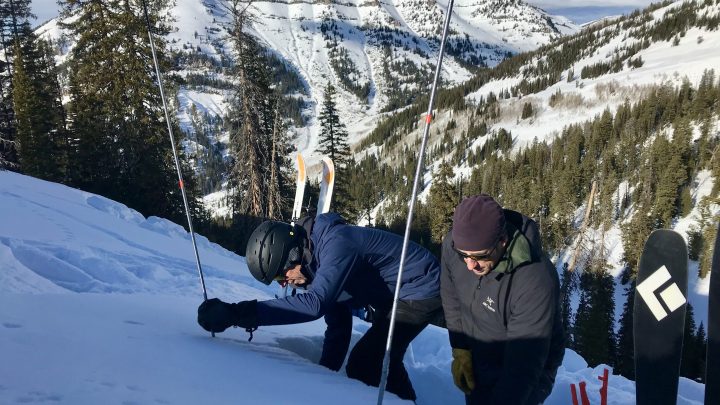
Wyoming avalanche center crowdsources to create safer slopes
Wyoming avalanche center crowdsources to create safer slopes

High up on a snowy ridge in the Teton mountains, Frank Carus and John Fitzgerald shoveled out a flat spot on a steep slope so they could see the snow’s layers. It’s was a beautiful bluebird day, and they had big, puffy coats on.
An avalanche had occurred naturally there recently. They pointed to the likely culprit — a “crusty” layer of crystals where the slide started.
“We’ve had that sandwich crust, facet crust, down towards the bottom of the pack, but not at the ground,” Fitzgerald said.
Carus and Fitzgerald work as forecasters for the Jackson, Wyoming-based Bridger-Teton Avalanche Center, which provides daily avalanche forecasts. It’s their job to literally get their hands in the snow to test its stability on many different slopes — and see how it’s changed over time.
“A week or 10 days ago, both of these crusts were much firmer,” Fitzgerald said.
So Carus and Fitzgerald had one more data point for their next forecast — a crucial tool for recreators as they decide where to safely ski and snowmobile. But Carus said there’s only so much they can monitor.
“There’s basically six forecasters trying to cover 7,000 square miles of forecast area, and each of our mountain ranges have some unique weather and avalanche conditions,” he said.
That 7,000 square miles covers part of northwest Wyoming.
“There are also a lot of blank spaces on the map that are where people are riding and snowmobiling without an avalanche forecast to say, ‘Hey, today the avalanche danger is high or low or considerable or extreme,” said Dwayne Meadows, executive director of the Bridger-Teton Avalanche Center Foundation.
Eastern Wyoming is one of those blank spaces, where snowmobiling is on the rise.
“The biggest part of Wyoming’s winter tourism economy is snowmobiling. [It’s] bigger than skiing, and it provides a lot for a lot of tiny, little towns all over the state,” said Meadows.
The number of visiting snowmobilers in Wyoming increased by almost 40% from 2012 to 2021, according to a state report.
The number of snowmobilers killed in avalanches is also up. Meadows said advances in snow machine technology may lead some riders to take more risks.
“The snowmobiles are a lot easier to ride, and they’re lighter and they’re faster and people are getting themselves in trouble,” he said.
To fill in some of the gaps in avalanche forecasting, the Bridger-Teton Center created an Information Exchange web page for eastern Wyoming. Meadows said it’s basically a crowdsourcing tool for community observations about snow stability in the area’s mountain ranges.
“If you’re out snowmobiling, you can say, ‘Hey, I saw that avalanche’ and post a picture. And that helps other people who are out there be like, ‘Oh, it is a little dangerous’,” he said.
Heather Tupper, a volunteer with the Snowy Range Snowmobile Club in eastern Wyoming, has seen the sport explode.
“Every year, there’s always people that have never been here. Even the elevation can be something that people just don’t realize,” she said.
The new crowdsourcing tool will be useful, she added, especially as snowmobilers continue to push further into the backcountry to avoid crowds.
“There are spots that are avalanche prone. It’s rare, but that doesn’t mean it doesn’t happen,” Tupper said.
And when it comes to staying safe in avalanche terrain, a little more information might make a big difference.
There’s a lot happening in the world. Through it all, Marketplace is here for you.
You rely on Marketplace to break down the world’s events and tell you how it affects you in a fact-based, approachable way. We rely on your financial support to keep making that possible.
Your donation today powers the independent journalism that you rely on. For just $5/month, you can help sustain Marketplace so we can keep reporting on the things that matter to you.

















